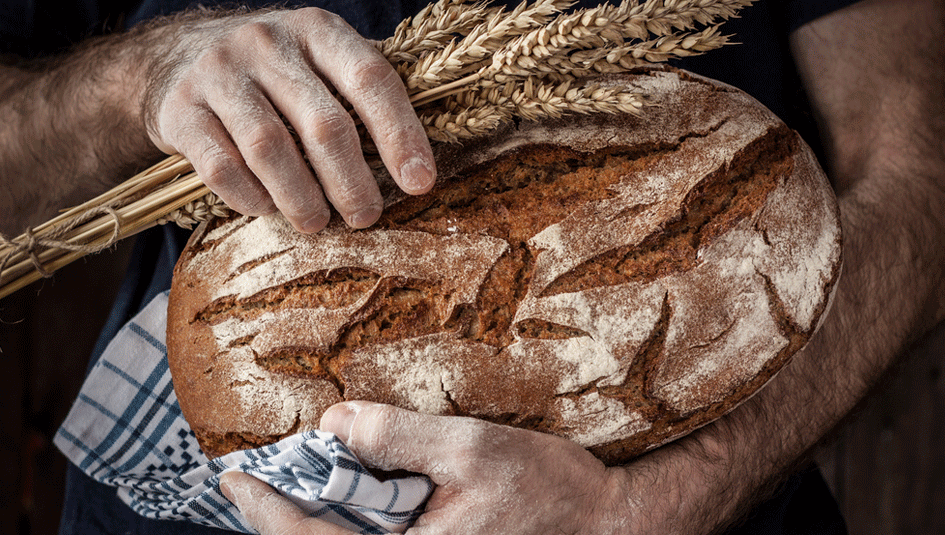The Whole Grains Riddle

In September of this year, national news outlets carried a story about the Nashoba Brook Bakery in Concord, Massachusetts being cited for violating the U.S. Food and Drug Administration food ingredient listing rules when it included “love” as an ingredient of its granola. It turns out that love was only a part of the list of violations. The warning letter the FDA sent to the bakery on September 22 also blew the whistle on the bakery’s hearty whole grain loaf. If it’s made predominantly from wheat flour with cornmeal added, then it can’t be called a “whole grain” loaf of bread said the FDA.
A year earlier, the Center for Science in the Public Interest and a group of consumers took the Kellogg Company into federal court and accused the 110-year-old breakfast cereal and bakery goods company of misrepresenting the health-promoting nature of Cheez-It Whole Grain crackers. Their complaint: Cheez-It Whole Grain crackers may in fact be made with whole grains, but that doesn’t make them “whole grain” crackers.
These two legal controversies are linked by U.S. dietary guidelines that have not only shifted considerably over more than a century, but they are also impacted by an 11-year delay by the FDA to issue a “whole grain” standard that is agreeable to the grain milling and bakery goods industries for use on food packaging and ingredient labels.
Why An Understanding Of “Whole Grains” Matters To People With Diabetes
Current thinking among nutritionists is that the best foods to promote overall health are those that are nutrient dense,M meaning foods that deliver high nutrient value per calorie. Among these are fresh fruits, leafy vegetables, poultry, fish, and voila, whole grains.
Whole grains, left intact or milled in a process that saves all the parts of the grain, can deliver sufficient nutrition from minerals, vitamins, and fiber per calorie to be a superior source of nutrition for people who have diabetes. But that nutrition will come with the disadvantage of having been delivered in a food that is, by its very nature, substantially higher in carbohydrates than are the plant-derived foods in the other food groups.
On the other hand, whole grains also deliver substantial benefits to the heart and circulatory systems, and to the digestive process. The fiber from the outer shell, sometimes reclaimed in the milling process as the bran, slows the breakdown of the starchy part of the grain into glucose, helping to moderate post-prandial elevation of blood sugar. Fiber helps lower serum cholesterol and can also help to lower blood pressure.
Key to people with diabetes is to find a balance between the nutritional value found in the hull and the germ of the grain — vitamins, minerals, micronutrients, and dietary fiber — and the carbohydrate content of the grain’s endosperm starchy component. Unfortunately, until the FDA makes a decision on what constitutes “whole grains” and this information is then accurately reflected on product nutrition labels – estimated to be at least four years away – it isn’t possible to compare products and make an infallible determination of what bread, cracker, energy bar, or breakfast cereal will deliver the best low-sugar nutrition with each calorie.
Fortunately, there’s still common sense to rely on – along with input from your certified diabetes educator or a nutritionist. In addition, here are some points to consider:
- Grain Group vs. Another Food Group. It makes very little sense for anyone who has diabetes to opt for a grain-based food v.s. a low-fat protein such as poultry, fish, lean meat, or a reduced or no-fat dairy product. Nor does it make sense to opt for a grain-based food as a better source of beneficial carbohydrates than fresh fruit or leafy vegetables. Remember that the more refined the grain, the less likely it will have retained the nutrients from the husk and the germ, and the more likely it will have had a stabilizing agent added to extend shelf life. The carbohydrate calories you will be taking in will probably be “emptier” than calories from other foods.
- Eating Whole (Or Nearly Whole) Grains. Whole grains really do exist, both in nature and more and more often these days in grocery stores. If you are going to eat grain foods, the American Diabetes Association recommends that you “pick the ones that are the most nutritious,” providing ample fiber, vitamins and minerals, plant protein, and beneficial oils relative to their glycemic loads. Bulgur (or cracked) wheat, whole barley, quinoa, millet, brown rice and wild rice, and whole rye are among those listed by the ADA as beneficial whole grains and are commonly available packaged or in bulk from grocery retailers.
- Deciphering Package Labels. There are two: the ingredient list and the nutrition facts label.
FDA has published online its current ingredient listing guidance in Q&A format. Although not specific to the baked goods industry, Q&A 1-3 explain in fairly simple terms where to find the ingredient list on the retail package and how ingredients are listed in order of weight and by commonly understood or used terms. The ingredient list may appear below the nutrition facts label or anywhere else where it is clearly readable. The ingredients will be listed in order, from the first one, which makes up the greatest proportion of the product, by weight, to the last one, which is the smallest proportion of the product, by weight.
Looking at a wheat bread package label, as an example, the first ingredient to appear will in nearly every instance be flour, or water, and the flour will be described according to one of the designations prescribed by FDA regulation, such as “white flour,” “plain flour,” “wheat flour,” “whole wheat flour,” or “entire wheat flour.”
You may find, as you read through the ingredient list, that there has been bran, or whole, crushed, or flaked grains, added to the dough or grain baked into the crust, and if so the grain used will be identified.
You may also find that two or more flours, such as oat or rye, whole or refined, have been combined with the wheat flour. Don’t assume, though, that a “multigrain” or “ancient grains” product is automatically healthier than any other. “Multi” means more than one, and all grains are at least as “ancient” as Mesopotamia.
Once you have determined whether the ingredients you want are in the product, then you can turn to the Nutrition Facts label. For our bread example, serving size is either one or two slices, and the serving size is measured in grams. The “Total Carbohydrates” boxes will tell you how much of that serving weight comes in carbohydrates from fiber and carbohydrates from sugars. Certainly, navigating this label isn’t as intuitive and straightforward as running through the ingredients list, but FDA does provide a fairly comprehensive tutorial on its site, updated in February 2017 to reflect the changes made to the label in March 2016.
Healthy – and Unhealthy – Competition in the Healthy Foods Business
National brand food makers, and the distributors and merchants who market their products, have been trying for more than 20 years to reinvent themselves as suppliers of healthy foods made from simple ingredients. Fortune Magazine, reporting on this in 2015 as a cultural change, as much as a commercial upheaval, and almost a year before the Cheez-Its case would be filed, called this a search for authenticity in product ingredients. Undoubtedly, there are manufacturers who have legitimately been moving toward such authenticity, but there are others who appear to have gone not much further than to revamp their packaging. “Putting the barn on the package,” a defensive marketing strategy in what’s been coined the War on Big Food, seems to be what Kellogg’s has been accused of doing.
While the Concord, Massachusetts bakery that ran afoul of the FDA’s descriptive labeling rules, didn’t start up in a barn (it was an old warehouse), it is one of thousands of small, local, specialty food companies running, very modestly in comparison, an offensive strategy in the food wars. The farm-to-table alliances of small growers with restaurants, and with regional grocers, have become a commercial force to be reckoned with. Some journalists covering the food and beverage retailing industry believe that the force will continue to be with us.
The History of U.S. Dietary Guidelines, In a Nutshell
In 1902, Wilbur O. Atwater, a professor of agricultural chemistry and chief of the U.S. Department of Agriculture’s experimental farming program, wrote in USDA Farmer’s Bulletin No. 142:
Unless care is exercised in selecting food, a diet may result which is one-sided or badly balanced, that is one in which either protein or fuel ingredients (carbohydrate and fat) are provided in excess … The evils of overeating may not be felt at once, but sooner or later they are sure to appear, perhaps in an excessive amount of fatty tissue, perhaps in general debility, perhaps in actual disease.
How to measure a food’s glycemic load, or how much and how quickly plant or dairy sugars could raise blood glucose, was still decades away. It would be another 35 years before British physician Harold Himsworth would distinguish Type 2 diabetes from Type 1 and write and lecture on the “mechanism” of T2D, a problem starting with insulin insensitivity in tissue, not the inability of the body to produce it. Dr. Himsworth would also be among the first to note the close association of obesity to T2D.
But Professor Atwater, it seems, was already on to the concept of nutrient density when he’d joined the USDA. His writings in 1902 took on the point of view of a food economist, highlighting a problem he saw with people storing more fuel than they needed, and an agricultural economy that favored overproduction of that fuel. Whether he knew it or not, as he wrote about too much dietary fat and sugar ushering in “debilities and actual diseases,” he was laying the foundation for the public health role the USDA carries out today. From time to time since 1917, the USDA has published dietary guidance, and since 1980 collaborated with the Department of Health and Human Services in this responsibility, to carry on Professor Atwater’s work.
As a follow up to that work, the first USDA food guide publication, How to Select Foods, was published in 1917, which introduced Americans to five groupings of foods along with recommended daily servings from each group, for children and adults.
- Milk and meat
- Cereals
- Fruits and vegetables
- Fats and fatty foods
- Sugars and sugary foods
Over the next 60+ years, the five groups became seven, the seven became the basic four, and for a few years there were twelve, as the American diet became a public health concern of wider interest in Washington. In 1977, the Senate Select Committee on Nutrition and Human Needs issued its own Dietary Goals for the United States, having decided according to its chair, Senator George McGovern, that the public was “confused about what to eat to maximize health.” In July 1979, U.S. Surgeon General Julius Richmond sent the report Healthy People: The Surgeon General’s report on Health Promotion and Disease Prevention to Secretary of Health, Education and Welfare (HEW) Joseph Califano, drawing on research done by the American Society for Clinical Nutrition. The report concluded that variations among people, due to age, levels of physical activity, and presence of chronic illness, made uniform dietary standards for Americans “impossible to establish.”
The Surgeon General observed, though, that Americans would “probably be healthier” if they consumed “less sugar, and relatively more complex carbohydrates such as whole grains, cereals, fruits and vegetables.”
As noted earlier, USDA and HEW (now the Department of Health and Human Services) first collaborated the following year, 1980, to publish the Dietary Guidelines for Americans and to update it every five years. The 1995 edition featured the well-known USDA food pyramid which had been introduced in 1992, putting the fats, oils, and sweets group at the tip of the pyramid, to be used sparingly, and the bread, cereal, rice, and pasta group at the base, with a recommended 6-11 daily servings. Understandably, nutritionists working with people with diabetes criticized the six-group pyramid and the 1995 Guidelines for suggesting a daily diet so prominently made up of refined grain products.
The bread, cereal, rice and pasta food group became the grain group in the 2000 Guidelines, with a note that the recommended daily intake consist of “especially whole grains.” In 2005, the “make half your grains whole” recommendation entered the Guidelines, to promote lowering intake of refined grain products in favor of increasing intake of fiber, vitamins, and minerals lost in the milling of grain to make flour.
The MyPyramid configuration of five food groups was rolled out for the 2005-2010 Guidelines edition. Then in 2011 MyPlate replaced it, in hopes of making food choices easier to comprehend. (Whether that has been fully accomplished is uncertain, if the Kellogg’s and the Nashoba Brook Bakery stories are any indication.) The 2015-2020 Guidelines kept us at five groups, same number as in 1917 and 2000, but realigned as
- Vegetables
- Fruits
- Grains, refined and whole, with whole grains recommended at least half of grain intake
- Dairy
- Protein Food
In October 2016, the Center for Science in the Public Interest gave America a report card on its diet. CSPI graded us C- in our adherence to the USDA’s dietary grain guidelines, primarily because what we take in comes way too much from wheat grains processed into flour and way too little in foods like oats and rice. CSPI has often been critical of the agricultural and prepared food retailing industries for attempting to influence policy at USDA, and using unsubstantiated nutritional claims to sell foods high in fat and added sugar but low in nutrient density, but historically supportive of USDA’s efforts to give sound dietary advice based on scientific evidence. CSPI believes that it’s unfair to blame USDA for prevalence of obesity and chronic disease. The problem, it says, is that people just don’t follow the Guidelines. The problem could also so be that many Americans are still as confused as they were in 1977, when the U.S. Senate tried to tackle the problem of what to eat to stay healthy.
And there’s another possible reason for the confusion: Despite years and years of work at USDA and DHHS that has gone into studying American food buying and dining habits, the question of what exactly constitutes a whole grain food has yet to be determined. The FDA does define “whole wheat flour” as the product of the wheat milling process in which the “proportions of the natural constituents of such wheat, other than moisture, remain unaltered.” But when FDA wrote up the little Massachusetts bakery, it pointed to a whole grains product description guideline it had drafted in 2006 but had yet to finalize. When the draft was first published, the Federal Trade Commission, enforcer of federal consumer protection laws, commented that consumers need “simple, easy tools to help them decide” how foods fit into their diets. Specific to the whole grains riddle, the FTC wrote this to the FDA:
As FDA’s draft guidance recognizes, there is potential for consumers to be misled or confused by unqualified “whole grain” claims for products that contain a mixture of whole grain and refined grain. Many consumers may interpret such unqualified claims to mean that all or nearly all of the grain in the product is whole grain. Additional guidance from FDA on the appropriate use of “100% whole grain,” “whole grain,” “made with whole grain,” and other similar terms could reduce the risk that consumers will be misled or confused. One possible approach would be for FDA to provide guidance setting specific percentage and minimum content standards for the amount of whole grain in products bearing such unqualified claims.
A Cracker By Any Other Name
So, the Cheez-It case, when it’s briefed and argued later this year on appeal, will turn on whether a reasonable person can figure out what terms like “made with whole grains,” “made from whole grains,” and even “whole grain” actually mean.
To add to the uncertainty, the FDA nutrition facts label has undergone changes since 2016, but the compliance deadlines for small food manufacturers are being moved back to 2021.
In their federal court complaint, the purchasers of Whole Grain Cheez-Its pointed to the whole grains recommendation in the 2015 Edition of the Dietary Guidelines for Americans to bolster their claim that Kellogg’s was essentially trying to dress Whole Grain Cheez-Its up as health food. By way of contrast, the cracker buyers alleged, Nabisco Wheat Thins are “100% whole grain,” as are Nabisco’s Triscuits, and Pepperidge Farm’s “Baked With Whole Grain” Goldfish are “predominantly” whole grain, but Whole Grain Cheez-Its and Cheez-It Originals are pretty much the same thing, made primarily of enriched white flour.
The Kellogg Company argued that it prints right on the front of the box that Whole Grain Cheez-Its are “made with” whole grain, and that the required nutritional information on the package includes the gram weight of “whole grain per serving.” Enriched flour, incidentally is flour to which nutrients such as the B-complex vitamins thiamin, riboflavin, and niacin have been added, along with folic acid, iron, and maybe calcium. It’s the flour that goes into making a lot of the soft supermarket sandwich bread we remember fondly from our childhoods. It’s defined in the FDA regulations which set the standards for identifying 28 varieties of milled bakery and pasta flours, corn meals, and enriched rice.
The lower court judge in the Cheez-It case found that a reasonable cracker buyer would be “familiar with the fact of life” that a cracker isn’t composed primarily of whole grain but some kind of flour made from grain, and that a reasonable shopper, reading all the information on a Cheez-Its box before deciding to buy, would know enough about how they’d been made, and so Kellogg’s wasn’t deceiving anyone, and dismissed the complaint. In their appeal, the Kellogg’s customers and the Center for Science in the Public Interest again argue that the Federal Trade Commission comment noted above — about the possibility of misleading or confusing product descriptions on packages of “whole grain” products — ought to carry substantial weight, even though the ingredient list printed directly below the nutrition facts label on the side panel of the Cheez-It box didn’t mention whole grains at all. That label does, however, list “whole wheat flour” as the third, by weight, of eight ingredients.
In 2013, a group of six public health researchers in Boston who had been looking at the 2010 Guidelines published a paper advocating for a standard definition of a “whole grain” food. The authors looked at the fiber, sugar, sodium, energy (calorie), and trans-fat ingredients of 545 grain-based foods sold at two major grocery store chains. They also looked at five commonly used descriptive methods, including a well-known bakery trade association’s method, three USDA methods, and the American Heart Association’s method, for categorizing foods by their proportion of whole grain content. They found inconsistencies from method to method, allowing any particular food product to come out higher or lower in its true proportion of whole grain to refined grain material, depending upon the method followed. And they found that some of the products they’d examined which carried the trade association’s “whole grains” logo were, although high in fiber and low in trans-fat, higher in sugars and calories than some products which didn’t bear the logo. The researchers concluded that the American Heart Association method — a ratio of less than 1 unit carbohydrate to 10 of fiber — seemed the best among the five as an indicator of overall healthfulness.
The plain meaning of a “whole grain” is after all pretty straightforward. It’s the intact seed or kernel, made up of the germ, which is the embryonic material for a new plant, surrounded by the starchy endosperm, high in plant sugar to nourish the germ, and the hull, the fibrous outer protective layer. All grain food products, from the white sandwich bread at the supermarket to the nut-brown dense artisanal loaves at the boutique bakehouse cafe, start out with whole grains.
Carbohydrates Are Everywhere
Ever since the early twentieth century, when the USDA got into the healthy diet prescribing business, milk, fruits, and baked goods, all ready sources of carbohydrates, have figured prominently in USDA’s dietary recommendations. We cannot live without carbohydrates in our diet. But if we have diabetes, we cannot live very well at all if we take in too many.
It’s not that our government has been unsympathetic all these years to people who need to limit their carbohydrate intake. In fact, USDA and DHHS have said all along that the Guidelines present a diet adequate for a healthy person eating 2,000 calories a day, and that diets high in fats and carbohydrates are known to increase risk of diabetes and cardiovascular disease. More importantly, the Guidelines recognize specifically, and clearly state, that people who have chronic illnesses need to plan and follow diets appropriate to their individual nutritional needs in consultation with their health care professionals.




